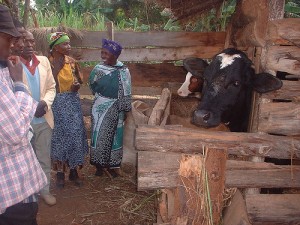Milk is milk,” says the Center for Global Food Issues (CGFI), a project to support technology and free-trade in the agricultural industry. In their view, all milk—whether from pasture-based, organic farms or produced from industrial, high-input milking operations—is an essential part of a healthy, well-balanced diet. “Supplements don’t change milk,” states their official ‘milk is milk’ website. “They just increase the cow’s ability to produce milk more efficiently.”
 But that claim “is hard to square with well-known facts,” says The Organic Center (TOC) in its 10 November report, A Dairy Farm’s Footprint: Evaluating the Impacts of Conventional and Organic Farming Systems. “The safety of milk varies substantially across farms as a function of somatic cell counts in milk, residues of synthetic pesticides and animal drugs, and pathogens.” The report concludes that organic dairy farming systems promote cow health and longevity because they put less stress on cows and feed them healthier diets. Healthier cows, in turn, produce more nutritious milk.
But that claim “is hard to square with well-known facts,” says The Organic Center (TOC) in its 10 November report, A Dairy Farm’s Footprint: Evaluating the Impacts of Conventional and Organic Farming Systems. “The safety of milk varies substantially across farms as a function of somatic cell counts in milk, residues of synthetic pesticides and animal drugs, and pathogens.” The report concludes that organic dairy farming systems promote cow health and longevity because they put less stress on cows and feed them healthier diets. Healthier cows, in turn, produce more nutritious milk.
In conducting the research for this report, TOC—an organization that supports and communicates science on the health and environmental benefits of organic food and farming—used an index called the “Shades of Green” (SOG) dairy farm management system calculator, developed by a team of dairy specialist. The SOG was first applied in a March, 2009 report entitled “Shades of Green: Quantifying the Benefits of Organic Dairy Production.” This report focused on the amount of land, pesticide, animal drugs, and synthetic fertilizer not used on organic dairy farms.
Other organizations and companies are developing their own sustainability indicators for chemical and energy use in the dairy sector, as well as impacts on greenhouse gas and nitrogen emissions. In 2006, a major greenhouse gas study by the Food and Agriculture Organization (FAO) of the United Nations attributed 18 percent of global greenhouse gas emissions to the livestock sector. A 2009 University of California-Davisreport estimates the figure to be around 3 percent. More accurate methodology for measuring the environmental footprint of the agricultural sector is clearly needed.
Since the release of the first SOG report, the calculator has been expanded and fine-tuned. In an effort to encourage further refinement and scrutiny, TOC plans to make the latest calculator, SOG Version 1.1, available on its website—free of charge—accompanied by detailed instructions for its use and justifications for its equations. TOC claims that it is the first to release a fully-operational dairy sector environmental footprint model.
The latest study, led by TOC Chief Scientist .and Nourishing the Planet Advisory Group member, Dr. Charles Benbrook, shows that dairy farming systems have multiple impacts on the environment, animal well-being, and the nutritional value and safety of dairy products. Key findings from the report include:
- On average, cows on organic dairy farms live 1.5 to 2 years longer and provide milk through twice as many, shorter lactations than conventional dairy operations.
- As a result, cow replacement rates are 30 percent to 46 percent lower on organic farms, reducing feed requirements.
- Cows on organic farms require 1.2 to 1.7 fewer breeding attempts per calf than cows on conventional dairy operations.
- Cows on forage-based diets produce milk with higher nutritional quality.
- Manure management systems on most organic farms produce 60 to 80 percent lower methane emissions than conventional dairy operations
Matt Styslinger is a research intern with the Nourishing the Planet project.

Danielle Nierenberg, an expert on livestock and sustainability, currently serves as Project Director of State of World 2011 for the Worldwatch Institute, a Washington, DC-based environmental think tank. Her knowledge of factory farming and its global spread and sustainable agriculture has been cited widely in the New York Times Magazine, the International Herald Tribune, the Washington Post, and
other publications.
Danielle worked for two years as a Peace Corps volunteer in the Dominican Republic. She is currently traveling across Africa looking at innovations that are working to alleviate hunger and poverty and blogging everyday at Worldwatch Institute’s Nourishing the Planet. She has a regular column with the Mail & Guardian, the Kansas City Star, and the Huffington Post and her writing was been featured in newspapers across Africa including the Cape Town Argus, the Zambia Daily Mail, Coast Week (Kenya), and other African publications. She holds an M.S. in agriculture, food, and environment from Tufts University and a B.A. in environmental policy from Monmouth College.








